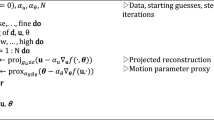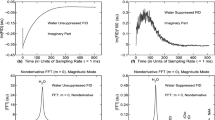Abstract
Purpose
Standard two-dimension (2D) magnetic resonance imaging (MRI) clinical acquisition protocols utilize orthogonal plane images which contain slice gaps (SG). The purpose of this work is to introduce a novel interpolation method for these orthogonal plane MRI 2D datasets. Three goals can be achieved: (1) increasing the resolution based on a priori knowledge of scanning protocol, (2) ameliorating the loss of data as a result of SG and (3) reconstructing a three-dimension (3D) dataset from 2D images.
Methods
MRI data was collected using a 3T GE scanner and simulated using Matlab. The procedure for validating the MRI data combination algorithm was performed using a Shepp–Logan and a Gaussian phantom in both 2D and 3D of varying matrix sizes (64–512), as well as on one MRI dataset of a human brain and on an American College of Radiology magnetic resonance accreditation phantom.
Results
The squared error and mean squared error were computed in comparing this scheme to common interpolating functions employed in MR consoles and workstations. The mean structure similarity matrix was computed in 2D as a means of qualitative image assessment. Additionally, MRI scans were used for qualitative assessment of the method. This new scheme was consistently more accurate than upsampling each orientation separately and averaging the upsampled data.
Conclusion
An efficient new interpolation approach to resolve SG was developed. This scheme effectively fills in the missing data points by using orthogonal plane images. To date, there have been few attempts to combine the information of three MRI plane orientations using brain images. This has specific applications for clinical MRI, functional MRI, diffusion-weighted imaging/diffusion tensor imaging and MR angiography where 2D slice acquisition are used. In these cases, the 2D data can be combined using our method in order to obtain 3D volume.












Similar content being viewed by others
References
Roullot E, Herment A, Bloch I, Nikolova M, Mousseaux E (2000). In: Herment A (eds) Proceedings of the 15th international conference on pattern recognition, vol 3, pp 346–349. doi:10.1109/ICPR.2000.903556
Herment A, Roullot E, Bloch I, Pellot C, Todd-Pokropek A, Mousseaux E (2002). In: Roullot E (ed) Proceedings of the IEEE international symposium on biomedical imaging, pp 947–950. doi:10.1109/ISBI.2002.1029418
Greenspan H (2009) Super-resolution in medical imaging. Comput J 52(1):43–63. doi:10.1093/comjnl/bxm075
Weishaupt VDKD, Marincek B (2006) How does MRI work? An introduction to the physics and function of magnetic resonance imaging. Springer, Berlin
Slavin GS, Bluemke DA (2005) Spatial and temporal resolution in cardiovascular MR imaging: review and recommendations. Radiology 234(2):330–338
Peled S, Yeshurun Y (2001) Superresolution in MRI: application to human white matter fiber tract visualization by diffusion tensor imaging. Magn Reson Med 45(1):29
Greenspan H, Oz G, Kiryati N, Peled S (2002) MRI inter-slice reconstruction using super-resolution. Magn Reson Imaging 20(5):437
Peeters RR, Kornprobst P, Nikolova M, Sunaert S, Vieville T, Malandain G, Deriche R, Faugeras O, Ng M, Hecke PV (2004) The use of super-resolution techniques to reduce slice thickness in functional MRI. Int J Imaging Syst Technol 14:131
Carmi E, Liu S, Alon N, Fiat A, Fiat D (2006) Resolution enhancement in MRI. Magn Reson Imaging 24(2):133. doi:10.1016/j.mri.2005.09.011
Shilling RZ, Robbie TQ, Bailloeul T, Mewes K, Mersereau RM, Brummer ME (2009) A super-resolution framework for 3-D high-resolution and high-contrast imaging using 2-D multislice MRI. IEEE Trans Med Imaging 28(5):633. doi:10.1109/TMI.2008.2007348
Kashou NH (2008) Development of functional studies and methods to better understand visual function. Ph.D. thesis, The Ohio State University
Waltz E, Llinas J (1990) Multisensor data fusion. Artech House, Boston
Hall D (1992) Mathematical techniques in multisensor data fusion. Artech House, Boston
Hall D, Llinas J (1997) An introduction to multisensor data fusion. Proc IEEE 85(1):6. doi:10.1109/5.554205
Varshney PK (1997) Scanning the special issue on data fusion. Proc IEEE 85:3
Shepard D (1968). In: Proceedings of the 1968 ACM national conference
Viola P, Wells WM III (1995) IEEE proceedings fifth international conference on computer vision. In: Computer vision, pp 16–23
Collignon A, Maes F, Delaere D, Vandermeulen D, Suetens P, Marchal G (1995) International conference information processing in medical imaging. In: Computational imaging and vision, pp 263–274
Maes F, Collignon A, Vandermeulen D, Marchal G, Suetens P (1997) Multimodality image registration by maximization of mutual information. IEEE Trans Med Imaging 16(2):187
Chen CC, Wan YL, Liu HL (2004) Quality assurance of clinical MRI scanners using ACR MRI phantom: preliminary results. J Digit Imaging 17(4):279. doi:10.1007/s10278-004-1023-5
Wells WM, Viola P, Atsumi H, Nakajima S, Kikinis R (1996) Multi-modal volume registration by maximization of mutual information. Med Image Anal 1(1):35
Wang Z, Bovik AC, Sheikh HR, Simoncelli EP (2004) Image quality assessment: from error visibility to structural similarity. IEEE Trans Image Process 13(4):600
Poot DHJ, Meir VV, Sijbers J (2010) General and efficient super-resolution method for multi-slice MRI. Med Image Comput Comput Assist Interv 13(Pt 1):615
Gholipour A, Estroff JA, Sahin M, Prabhu SP, Warfield SK (2010) Maximum a posteriori estimation of isotropic high-resolution volumetric MRI from orthogonal thick-slice scans. Med Image Comput Comput Assist Interv 13(Pt 2):109
Gholipour A, Estroff JA, Warfield SK (2010) Robust super-resolution volume reconstruction from slice acquisitions: application to fetal brain MRI. IEEE Trans Med Imaging 29(10):1739. doi:10.1109/TMI.2010.2051680
Gholipour A, Estroff JA, Barnewolt CE, Connolly SA, Warfield SK (2011) Fetal brain volumetry through MRI volumetric reconstruction and segmentation. Int J Comput Assist Radiol Surg 6(3):329. doi:10.1007/s11548-010-0512-x
Mahmoudzadeh AP, Kashou NH (2013) Evaluation of interpolation effects on upsampling and accuracy of cost functions-based optimized automatic image registration. Int J Biomed Imaging 2013:19. doi:10.1155/2013/395915
Lehmann TM, Gonner C, Spitzer K (1999) Survey: interpolation methods in medical image processing. IEEE Trans Med Imaging 18(11):1049. doi:10.1109/42.816070
Conflict of interest
The authors declare that they have no conflict of interest.
Author information
Authors and Affiliations
Corresponding author
Electronic supplementary material
Below is the link to the electronic supplementary material.
Supplementary material 4 (wmv 182 KB)
Supplementary material 5 (wmv 424 KB)
Rights and permissions
About this article
Cite this article
Kashou, N.H., Smith, M.A. & Roberts, C.J. Ameliorating slice gaps in multislice magnetic resonance images: an interpolation scheme. Int J CARS 10, 19–33 (2015). https://doi.org/10.1007/s11548-014-1002-3
Received:
Accepted:
Published:
Issue Date:
DOI: https://doi.org/10.1007/s11548-014-1002-3




